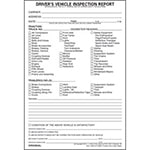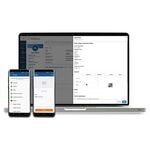Vehicle Inspections and truck maintenance can help you control costs and keep drivers safe on the road. A properly executed vehicle inspection can help your drivers:
- Discover unsafe conditions before they cause accidents or crashes
- Find mechanical problems before they lead to costly breakdowns
- Avoid being placed out of service during a DOT roadside inspection, or being subject to infractions and fines
Understanding critical information about performing a vehicle inspection, filling out vehicle inspection forms, and knowing how pre- and post-trip inspections impact DOT roadside inspections, helps protect your equipment, your drivers, and your organization's reputation.
And, not only do vehicle inspections make good sense – they are required. Drivers also need to know what to check on the vehicle and how to spot defects, who to call when there is a problem, and how and when to submit documentation.
A regimen of a complete pre-trip at the beginning of the day, walk-around inspection every time the vehicle is parked, and a post-trip at the end of the day is the best practice. That, coupled with a competent maintenance department, can keep your vehicles on the road, in good shape, and help keep your CSA BASIC scores low.
Resources
Topics — What You Need to Know
Customers that have a world class vehicle maintenance program share 6 key elements: operational planning, personnel and training, compliance management, parts management, recordkeeping, and preventive maintenance. Is your maintenance program world class? See below to find out.
Operational Planning
- Have a business plan containing the major objectives of the department.
- Include all the major tasks that need to be completed.
- Set goals that are specific, measurable, achievable, and realistic within a given time frame.
- Make sure what gets measured gets done.
- Identify who is responsible for what.
- Determine the financial impact (good or bad) of the maintenance department and the operational plan.
- Use the FMCSA’s Safety Management Cycle or another model based on the LEAN principle.
Personnel and Training
- Recruit and retain qualified and certified technicians for annual/periodic inspections, brake inspections and A/C repairs.
- Provide initial training and retraining for mechanics and drivers.
- Make sure drivers know who to call when there is a problem and how and when to submit documentation.
- Allow drivers to “red tag” equipment to alert other drivers and the maintenance team of needed repairs.
- Celebrate success and share the savings. This need not be a “bonus” program; it may simply take the form of gas cards or certificates that recognize when an associate contributes to high-level objectives by executing their role well.
Compliance Management
- Stay abreast of DOT, OSHA, and EPA regulatory requirements and follow them.
- Track every roadside violation and repair request. Watching these two data sets can indicate a problem with the maintenance program or a problem with specific equipment.
- Post CSA scores in multiple visible areas of the company.
Parts Management
- Know sources for parts (new, used, rebuilt, and remanufactured), and warranties.
- Track your parts and supplies inventory, costs, and reorder points.
- Report cost by vehicle, work performed, or per mile.
- Compare repair expenses to revenues generated and use this information to establish replacement benchmarks for each piece of equipment.
Recordkeeping
- Have an electronic system in place that issues alerts for preventive maintenance and annual inspections, and which tracks repairs, inventory, and costs.
- Maintain DVIR records for all post-trip inspections, not just when a defect is found.
- Consider eDVIRS for drivers with the use of an Electronic Logging Device.
- Track mechanics' hours.
Preventive Maintenance
- Consider quarterly preventive maintenance (PM) reviews. It pays to have a qualified mechanic take a deeper look more than once a year. This will be an investment in “peace of mind” and provide lower overall operational expenses.
- Based on the needs of the company, determine PMs by time, miles, or engine hours.
- Have an established schedule for trailers, lift gates, and other special equipment, as well as power units.
- Have an “inspection lane,” which is a designated lane or shop where vehicles enter or exit the facility. Drivers can bring up complaints and have them checked on the spot.
- In place of an inspection lane (which may be too expensive or cumbersome for every fleet), use yard checks." This involves having technicians, at specified times throughout the day, “cruise” the yard and check all equipment that is newly arrived in the yard.
- Conduct random “stakeouts” at customers, lots, or fuel locations, to observe your drivers. Track how many drivers do the required inspections.
- Conduct pre-service inspections on new equipment or equipment that has been inactive for a while.
- Contact the Original Equipment Manufacturer (OEM) that built the vehicles. Most OEMs have an inspection and preventive maintenance (PM) schedule available for the vehicles they build.
- Establish “pull points” or “cut-off points.” This is a pre-determined “wear and tear” threshold that, when reached, is the trigger for the part or component to be removed and replaced.
Inspection & Maintenance Solutions
Get the forms you need to comply with vehicle inspection and maintenance requirements. Choose from paper or electronic solutions as well as a wide assortment of form types. Plus, get accurate, up-to-date regulatory information with training programs and publications.
DOT vehicle inspection forms provide checklists for inspecting a wide range of vehicles and help you document and report necessary repairs for regulatory compliance.
Repair orders and maintenance file packets help you authorize, schedule and record preventive maintenance or repairs.
Annual Vehicle Inspection Reports & Labels
AVIR forms & stickers help you conduct and verify annual vehicle inspections to improve fleet safety and ensure compliance with DOT requirements.
Vehicle Inspections & Maintenance Training
Driver training provides critical information on complying with DOT requirements for vehicle inspections, roadside inspections and more.
J. J. Keller® Encompass® eDVIR App
An electronic DVIR application that allows you to customize vehicle inspections and time tracking.
J. J. Keller® Encompass® Service
Online vehicle maintenance with preventive maintenance alerts, asset tracking, and parts inventory.
Provide drivers with info needed to conduct successful pre-trip, en-route, and post-trip inspections.







